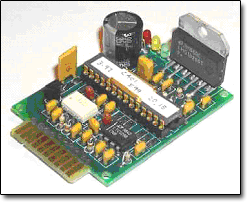 |
S6PWM
R/C Servo Motor Controller
|
Applications
- R.O.V.s, U.A.Vs., R.P.Vs.
- Special Effects
- Aerospace
- Robotics / A.I.
- Animatronics
|
Features
- Digital PID servo control
- 12 bit A/D coversion
- R/C or Analog input
- Opto isolated R/C input
- No Programming Required
|
The S-series is a Precision high-performance, digitally controlled, H-bridge servo motor controller. The input signal may be either a PCM signal from a conventional radio-control receiver or from a potentiometer or analog signal. The unique Bio-MotionTM digital signal processing may be utilized to produce smoother, more life-like movement. A built-in self-test mode and three LED indicators simplify system testing and maintenance. The power source may be 12 to 32 volts DC. Special PID program codes are precision tuned for our products and their characteristics. See S-Series user manual for more info.
These controllers mate directly to our servo actuators as part of a modular system. All �Plug and Play� systems are wired up, including connectors, then factory tested. Just plug in power and signal then your good to go.
Specifications
| Input Signal: | PWM R/C receiver type. 1.0 to 2.0 msec. +5V @ .7mA min. Period, 6 to 22msec |
| Optional Input: | Analog; 2K to 20K potentiometer, or 0 to 5 Volts |
| Resolution: | 12 bits, approximately actuator stroke x .0002" � .001" |
| Power source: | Minimum 12 volts DC, maximum 32 volts DC |
| No-load input current: | Typically <25 mA |
| Full-load output current: | Up to 6 amps with suitable heat-sinking |
| Temp. Range: | 0 to 70°C |
| Dead-band: | < 0.001 msec |
| Size: | 1.69� x 2.40� x 0.9" thick, without heat-sink |
| Weight: | 4 grams |
| Data Sheet: | S-Series Data Sheet |
| Manual: | S-Series Manual |
|
- High frequency (31.25 kHz) Pulse Width Modulation motor drive for smooth, quiet operation.
- Soft start during the first 8 seconds after power is applied.
- Bio-MotionTM digital signal processing algorithms produce life-like motion.
- Typically 10 to 20 times more accurate servo positioning than many existing products.
- Ignores invalid input pulse widths using digital filtering techniques.
- Fault indicator LEDs:
- Red LED indicates loss of input or presence of invalid pulse width.
- Yellow LED indicates over-temp or over-current shutdown.
- Green LED blinks to indicate normal operation of the control system processor.
- Stores last valid RC input signal when input signal is lost or corrupted.
|

